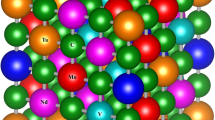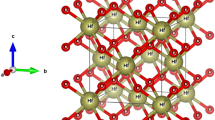Abstract
The physical properties of transition metal dichalcogenides (TMDs) with a few layers can be tailored by strain engineering because of the good elasticity with a strain limit of more than 10 %. In this work, elastic deformation under uniaxial tension in single-layer MoS2 nano-sheets is investigated theoretically by molecular dynamics simulation. A size-dependent elastic modulus is observed especially from sheets with a width of less than 10 nm. The elastic modulus of the nano-sheets with zigzag edges decreases as the width becomes narrower but that of the nano-sheets with armchair edges increases anomalously. The anisotropic behavior is ascribed to the opposite variation of the edge stress induced by the atomic configurations at the edges. Based on the continuum theory, a composite model composed of edge and core regions is established and the parameter, α, is adopted to describe the edge stiffness. The value of α is negative and positive for the zigzag and armchair edges, respectively, but the fitted edge width is 0.63 nm that is independent of the edge chirality.







Similar content being viewed by others
References
Xu M, Liang T, Shi M, Chen H (2013) Graphene-like two-dimensional materials. Chem Rev 113:3766–3798
Ataca C, Şahin H, Ciraci S (2012) Stable, Single-layer MX2 transition-metal oxides and dichalcogenides in a honeycomb-like structure. J Phys Chem C 116:8983–8999
Li LF, Wang YL, Xie SY, Li XB, Wang YQ, Wu RT, Sun HB, Zhang SB, Gao HJ (2013) Two-dimensional transition metal honeycomb realized: Hf on Ir (111). Nano Lett 13:4671–4674
Jin C, Lin F, Suenaga K, Iijima S (2009) Fabrication of a freestanding boron nitride single layer and its defect assignments. Phys Rev Lett 102:195505
Brent JR, Savjani N, Lewis EA, Haigh SJ, Lewis DJ, O’Brien P (2014) Fabrication of a freestanding boron nitride single layer and its defect assignments. Chem Commun 50:13338–13341
Meng L, Wang YL, Zhang LZ, Du SX, Wu RT, Li LF, Zhang Y, Li G, Zhou HT, Hofer WA (2013) Buckled silicene formation on Ir (111). Nano Lett 613:685–690
Huang X, Zeng ZY, Zhang H (2013) Metal dichalcogenide nanosheets: preparation, properties and applications. Chem Soc Rev 42:1934–1946
Mak KF, Lee C, Hone J, Shan J, Heinz TF (2010) Seeing many-body effects in single- and few-layer graphene: observation of 2-dimensional saddle point excitons. Phy Rev Lett 05:136805
Sundaram RS, Engel M, Lombardo A, Krupke R, Ferrari AC, Avouris P, Steiner M (2013) Electroluminescence in single layer MoS2. Nano Lett 13:1416–1421
Wu Z, Fang B, Wang Z, Wang C, Liu Z, Liu F, Wang W, Alfantazi A, Wang D, Wilkinson DP (2013) MoS2 nanosheets: a designed structure with high active site density for the hydrogen evolution reaction. ACS Catal 3:2101–2107
Fontana M, Deppe T, Boyd AK, Rinzan M, Liu AY, Paranjape M, Barbara P (2013) Electron-hole transport and photovoltaic effect in gated MoS2 schottky junctions. Sci Rep 3:1634
Shanmugam M, Durcan CA, Yu B (2012) Layered semiconductor molybdenum disulfide nanomembrane based schottky-barrier solar cells. Nanoscale 4:7399–7405
Mak KF, McGill KL, Park J, McEuen PL (2014) The valley hall effect in MoS2 transistors. Science 344:1489–1492
Feng J, Qian X, Huang CW, Li J (2012) Strain-engineered artificial atom as a broad-spectrum solar energy funnel. Nat Phot 6:866–872
Guinea F, Katsnelson MI, Geim AK (2010) Energy gaps and a zero-field quantum hall effect in graphene by strain engineering. Nat Phys 6:30–33
Ong MT, Reed EJ (2011) Engineered piezoelectricity in graphene. ACS Nano 6:1387–1394
Scalise E, Houssa M, Pourtois G, Afanas’ev V, Stesmans A (2012) Strain-induced semiconductor to metal transition in the two-dimensional honeycomb structure of MoS2. Nano Res 5:43–48
He K, Poole C, Mak KF, Shan J (2013) Experimental demonstration of contiuous electric structure tuning via strain in atomically thin MoS2. Nano Lett 13:2931–2936
Ding ZW, Jiang JW, Pei QX, Zhang YW (2015) In-plane and cross-plane thermal conductivities of molybdenum disulfide. Nanotechnol 26:065703
Chen XF, Qia JS, Shi DN (2015) Strain-engineering of magnetic coupling in two-dimensional magnetic semiconductor CrSiTe3: competition of direct exchange interaction and super exchange interaction. Phys Lett A 379:60–63
Bertolazzi S, Brivio J, Kis A (2011) Stretching and breaking of ultrathin MoS2. ACS Nano 5:9703–9709
Cooper RC, Lee C, Marianetti CA, Wei XD, Hone J, Kysar JW (2013) Nonlinear elastic behavior of two-dimensional molybdenum disulfide. Phys Rev B 87:035423
Wang Z, Devel M (2011) Periodic ripples in suspended graphene. Phys Rev B 83:125422
Feruz Y, Mordehai D, Towards A (2016) Universal size-dependent strength of face-centered cubic nanoparticles. Acta Mater 103:433–441
Singh SK, Neek-Amal M, Costamagna S, Peeters FM (2015) Rippling, buckling, and melting of single-and multilayer MoS2. Phys Rev B 91:014101
Ma F, Sun YJ, Ma DY, Xu KW, Chu PK (2011) Reversible phase transformation in graphene nano-ribbons: lattice shearing based mechanism. Acta Mater 59:6783–6789
Kadantsev ES, Hawrylak P (2012) Electronic structure of a single MoS2 monolayer. Solid State Commun 152:909–913
Liang T, Phillpot SR, Sinnott SB (2009) Parametrization of a reactive many-body potential for Mo–S systems. Phys Rev B 79:245110
Jiang JW, Park HS, Rabczuk T (2013) Molecular dynamics simulations of single-layer molybdenum disulphide (MoS2): Stillinger-Weber parametrization, mechanical properties, and thermal conductivity. J Appl Phys 114:064307
Jiang JW (2015) Parametrization of Stillinger-Weber potential based on valence force field model: application to single-layer MoS2 and black phosphorus. Nanotechnol 26:315706
Subramaniyan AK, Sun CT (2008) Continuum interpretation of virial stress in molecular simulation. Int J Solids Struct 45:4340–4346
Xiong S, Cao GX (2015) Molecular dynamics simulations of mechanical properties of monolayer MoS2. Nanotechnol 26:185705
Zhao JH, Kou LZ, Jiang JW, Rabczuk T (2014) Tension-induced phase transition of single layer molybdenum sisulphide (MoS2) at low temperatures. Nanotechnol. 25:295701
Reddy CD, Ramasubramaniam A, Shenoy VB, Zhang YW (2009) Edge elastic properties of defect-free single-layer graphene sheets. Appl Phys Lett 94:101904
Le MQ (2015) Prediction of Young’s modulus of hexagonal monolayer sheets based on molecular mechanics. J Mech Sci Tech 11:15–24
Lu Q, Gao W, Huang R (2013) Atomistic simulation and continuum modeling of graphene nanoribbons under uniaxial tension. Modell Simul Mater Sci Eng 19:054006
Jing YH, Sun Y, Niu HW, Shen J (2013) Atomistic simulations on the mechanical properties of silicene nanoribbons under uniaxial tension. Phys Status Solidi B 8:1505–1509
Liu X, Yang QS, He XQ, Liew KM (2012) Size- and shape-dependent effective properties of single-walled super carbon nanotubes via a generalized molecular structure mechanics method. Comput Mater Sci 61:27–33
Sainath G, Choudhary BK (2015) Molecular dynamics simulations on size dependent tensile deforma- tion behaviour of [110] oriented body centred cubic iron nanowires. Mater Sci Eng, A 640:98–105
Zhao H, Min K, Aluru NR (2009) Size and chirality dependent elastic properties of graphene nanoribbons under uniaxial tension. Nano Lett 9:3012–3015
Liu WT, Hsiao C, Hsua WD (2014) Role of surface on the size-dependent mechanical properties of copper nano-wire under tensile load: a molecular dynamics simulation. Appl Surf Sci 289:47–52
Chen CQ, Shi Y, Zhu J, Yan YJ (2006) Size dependence of Young’s modulus in ZnO nanowires. Phys Rev Lett 96:075505
Zheng YG, Zhao YT, Ye HF, Zhang HW (2014) Size-dependent elastic moduli and vibrational properties of fivefold twinned copper nanowires. Nanotechno 25:315701
Qiao L, Zheng XJ (2013) Effect of surface stress on the stiffness of micro/nanocantilevers: nanowire elastic modulus measured by nano-scale tensile and vibrational techniques. J Appl Phys 113:013508
Zhang TY, Wang ZJ, Chan WK (2010) Eigenstress model for surface stress of solids. Phys Rev B 81:195427
Yao HY, Yun GH, Bai N, Li JG (2012) Surface elasticity effect on the size-dependent elastic property of nanowires. J Appl Phys 111:083506
Dattaa D, Nadimpalli SPV, Li YF, Shenoyd VB (2015) Effect of crack length and orientation on the mixed-mode fracture behavior of graphene. Extreme Mechanics Letters 5:10–17
Pan H, Zhang YW (2012) Edge-dependent structural, electronic and magnetic properties of MoS2 nanoribbons. J Mater Chem 22:7280
Gan CK, Srolovitz DJ (2010) First-principles study of graphene edge properties and flake shapes. Phys Rev B 81:125445
Jun S, Li XB, Meng FC (2011) Elastic properties of edges in BN and SiC nanoribbons and of boundaries in C-BN superlattices: a density functional theory study. Phys Rev B 83:153407
Acknowledgements
This work was jointly supported by the National Natural Science Foundation of China (Grant Nos. 51271139, 51471130, 51302162, and 51171145), Natural Science Foundation of Shaanxi Province (Grant Nos. 2013JM6002 and 2014JQ1016), Fundamental Research Funds for the Central Universities, and City University of Hong Kong Applied Research, Grant (ARG) No. 9667104.
Author information
Authors and Affiliations
Corresponding authors
Rights and permissions
About this article
Cite this article
Bao, H., Huang, Y., Ma, F. et al. Size-dependent elastic modulus of single-layer MoS2 nano-sheets. J Mater Sci 51, 6850–6859 (2016). https://doi.org/10.1007/s10853-016-9972-x
Received:
Accepted:
Published:
Issue Date:
DOI: https://doi.org/10.1007/s10853-016-9972-x




